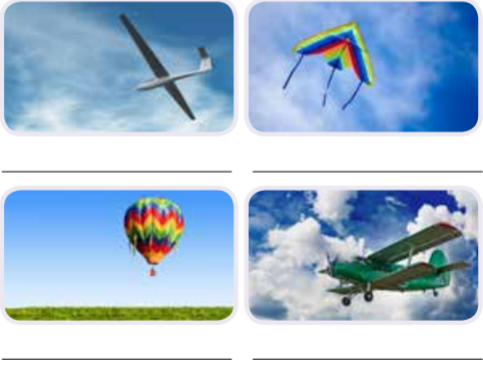Đừng bỏ lỡ những tính năng hấp dẫn của Baitap365.com
1. What flying machines are they? Label the photos with words from the box. 2. Read the text. Match the dates to the flying machines. 3. Read the text again. Choose true (T) or false (F). 4. Answer the questions. 5. PROJECT Use the Internet to search information about the history of one of the following inventions: train, car, or motorbike. . Find out important milestones in the development of the invention. Add pictures. Present your research to the class.
Bài 1
1. What flying machines are they? Label the photos with words from the box.
(Chúng là những máy bay nào? Gắn nhãn các bức ảnh bằng các từ trong hộp.)
|
glider hot-air balloon kite biplane |

Bài 2
2. Read the text. Match the dates to the flying machines.
(Đọc đoạn văn. Nối ngày tháng với máy bay.)
A short history of flying
The first flying machines of the hunian I kind were kites. Kites were invented by the Chinese about 2,000 years ago and were quickly spread around the world. They were usually triangle-shaped. Then, the invention of hydrogen gas led to the invention of hot-air balloon. A fire under the balloon made the air hot. In November 1783, two men flew a hot-air balloon in France for about 8 km. But people wanted to fly like a bird, so they made gliders – flying machines with very big wings. In the 1890s, they flew about 100 or 150 metres. People wanted to fly a longer way, so in 1902 in America, the Wright brothers made a biplane. It had two long wings. One wing was at the top and one was under it. And a year later, they made a biplane with an engine – the Wright Flyer. Biplanes with engines flew a long way, but people needed bigger planes. This happened in the 1950s. The British, Russians and Americans made planes for many people. They had big engines in or under the wings and they flew a very long way.

Bài 3
3. Read the text again. Choose true (T) or false (F).
(Đọc lại đoạn văn một lần nữa. Chọn đúng/sai.)
1. They made the first kites in China.
(Họ đã làm ra những con diều đầu tiên ở Trung Quốc.)
2. In 1783, there were three people in the hot-air balloon.
(Năm 1783, có ba người trên khinh khí cầu.)
3. Human beings made the first flying machine with wings before the first hot-air balloon.
(Con người đã tạo ra cỗ máy bay đầu tiên có cánh trước khi có khinh khí cầu đầu tiên.)
4. The Wright brothers made a flying machine with an engine.
(Anh em nhà Wright đã chế tạo ra một chiếc máy bay có động cơ.)
5. Biplanes had long wings.
(Máy bay 2 tầng cánh có những cánh dài.)
6. In the 1950s, only the Americans made big planes for many people.
(Vào những năm 1950, chỉ có người Mỹ mới chế tạo được những chiếc máy bay lớn cho nhiều người.)
Bài 4
4. Answer the questions.
(Trả lời câu hỏi.)
1. Do you like flying kites?
(Bạn có thích thả diều không?)
2. Do you think flying in planes is fun?
(Bạn có nghĩ rằng bay trên máy bay là thú vị?)
3. Do you want to fly in a hot-air balloon?
(Bạn có muốn bay trên khinh khí cầu không?)
4. What is your favourite flying machine in the text?
(Loại động cơ bay yêu thích của bạn trong văn bản là gì?)
Bài 5
5. PROJECT
(DỰ ÁN)
- Use the Internet to search information about the history of one of the following inventions: train, car, or motorbike.
(Sử dụng Internet để tìm kiếm thông tin về lịch sử của một trong những phát minh sau: tàu hỏa, ô tô hoặc xe máy.)
- Find out important milestones in the development of the invention. Add pictures.
(Tìm ra các mốc quan trọng trong quá trình phát triển của sáng chế. Thêm hình ảnh.)
- Present your research to the class.
(Trình bày nghiên cứu của bạn trước lớp.)
Mẹo tìm đáp án nhanh
Search Google: "từ khóa + baitap365" Ví dụ: "Bài 5 trang 13 SGK Vật lí 12 baitap365